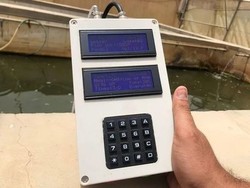
Science-KF device
The startup seeking to improve feed efficiency in Egypt’s tilapia sector
Editor/Mohamed Shihab
By:Yomna Elshamy-Egyptian aquaculture specialist- has a BSc in aquaculture and fisheries and lives in Egypt.
An Egyptian team has succeeded in developing a smart device to estimate the feed intake required for each tank on a fish farm, helping improve productivity and water quality.
The team behind the development came from the Faculty of Aquatic and Fisheries Sciences at Kafrelsheikh University and their goal was to develop the device to solve problems related to feed waste and the water quality problems it can cause.
Their end product, which was developed with the help of Ibn al-Nafis hatchery, is called the Smart Feed Estimation Device (SFED). This device can calculate the amount of feed required, based on the number of fish and the water temperature, thereby saving money for the farm.
It also improves water quality, by reducing the amount of unconsumed feed, thereby reducing the levels of ammonia.
According to the researchers, adjusting the feeding regime in relation to the water temperature is what makes the device so useful, as the temperature affects the metabolism of the fish. The device can also recommend the optimum percentage of protein in the feed, they say.
It also allows farmers to print a daily record of the amount of feed used, helping to ascertain how much feed is left in storage and whether any has been stolen.
“With the economic conditions that the world is going through, which resulted in high fish feed prices, we came up with the idea of making a device to determine the amount of feed needed by fish farms and reduce excess feeding,” they explain.
“By changing the percentage of protein in feeds farmers can reduce their production cost,” the researchers observe.
The devices can be adapted, according to the species and life stage of the fish being farmed.
“Each device differs according to the type of fish and the production system, but it is easy to change the purpose of the device by adding feeding tables for the type of fish and production system. The current version we have is designed primarily for tilapia because of the great popularity of tilapia in Egypt,” the researchers explain.
According to the researchers, the device is easy to operate.
“It does not require training, but a practical demonstration of how to operate it will do. Anyone can use it after practicing a few times, and the inputs required are easy to enter via the keyboard,” they say.
The device is already commercially available, but the team are open to outside investment in order to speed up its commercialisation.
The team say that they are grateful for the help of Dr Radi Ali Mohamed, vice-dean of the Faculty of Aquatic and Fisheries Sciences at Kafrelsheikh University, who was their first supporter and advised them throughout the design of the device.
“The device eliminates waste, achieves optimal benefit from it, improves productivity, and avoids preoccupation with improving water quality, as unconsumed amounts of feed represent the cause of most water problems. Therefore, the device and subsequent development are an excellent step by promising young people to contribute to the field of aquaculture,” says Dr Mohamed.
The researchers also collaborated with other academics and WorldFish, an NGO that supports the development of sustainable aquaculture, testing their device in earthen ponds and cement tanks in a farm run by the latter.
“Many experiments were carried out at the Ibn Al-Nafis hatchery and at WorldFish in the presence of our college professors, Dr Abdel Fattah Al-Sayed and Dr Ahmed Nasrallah, as well as a group of WorldFish researchers. WorldFish, found that the device was very effective,” they say.
The researchers are planning to launch the device commercially next March and say that a number of them have already been pre-ordered.
“We are currently in the stage of establishing a company with our own brand,” they say.
In the meantime they are aiming to add sensors for pH and oxygen, as well as reducing the size of the device.
The launch is eagerly awaited by players in the industry who have trialled the prototype. As Shadi Hamdi, executive director of Ibn Al-Nafis Hatchery for Tilapia and Ornamental Fish, reflects: “We have supported the device since its inception, believing in its importance in improving nutritional habits in fish farms and increasing profitability. We were the first to try the device and it achieved really good results. We have also successfully followed the nutritional tables programmed by the device in our hatchery.”


ساحة النقاش